Asakusa (Pronounced A-sak-sa), is an area of Tokyo full of history and is home of Tokyo’s oldest temple; Sensoji.
While most of Tokyo suffered a lot of damage during World War 2, a lot of buildings in Asakusa managed to survive, and some of those damaged were restored after the war. Making it is one of the places in Tokyo to view historical buildings, which are included below in the best things to do in Asakusa.
As someone who has visited Tokyo multiple times, and lived there for a while I’ve visited the Asakusa many times and it is easily one of my faveorite parts of Tokyo. With the Sensoji Temple, the Nakamise Shopping Street and some of the best Matcha ice cream in Tokyo are just some of the main highlights. But continue reading to see what I recommed seeing.
Kaminarimon
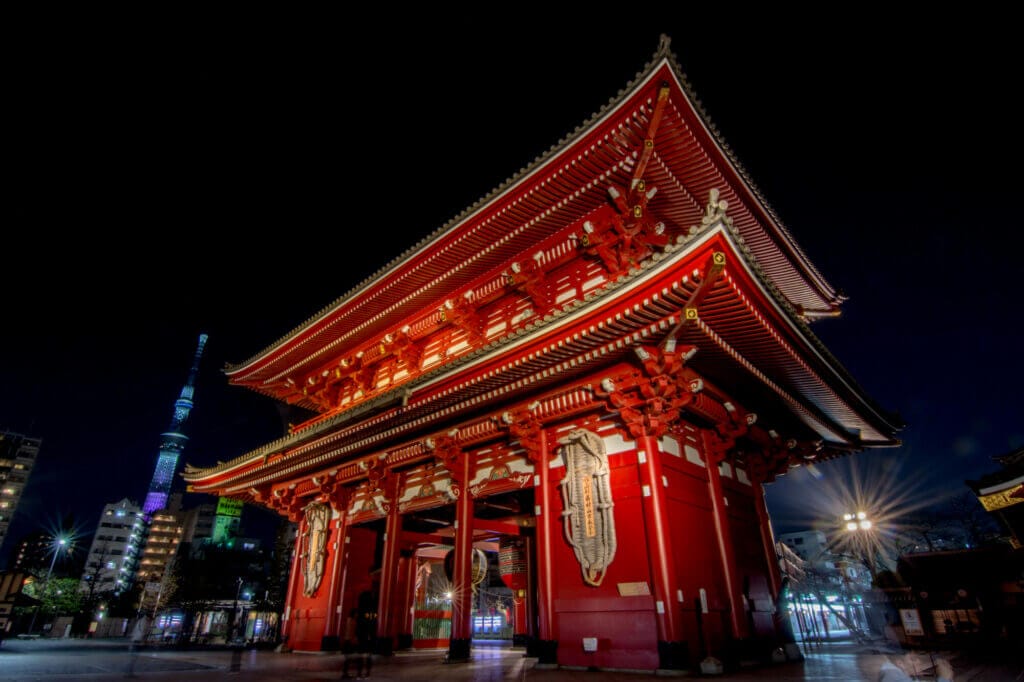
When you arrive at Asakusa, one of the first things you’ll see is the Kaminarimon (Thunder Gate), a grand temple gate that leads to the Sensoji temple. Built in 941, it has been destroyed by fire twice and rebuilt, with the current gate dating back to the 1960s. The gate is adorned with statues of Shinto and Buddhist gods, and at its center hangs a giant red chouchin (paper lantern) donated by Matsushita Electric Industrial Co. in 2003.
Sensoji Temple and Nakamise Shopping Street
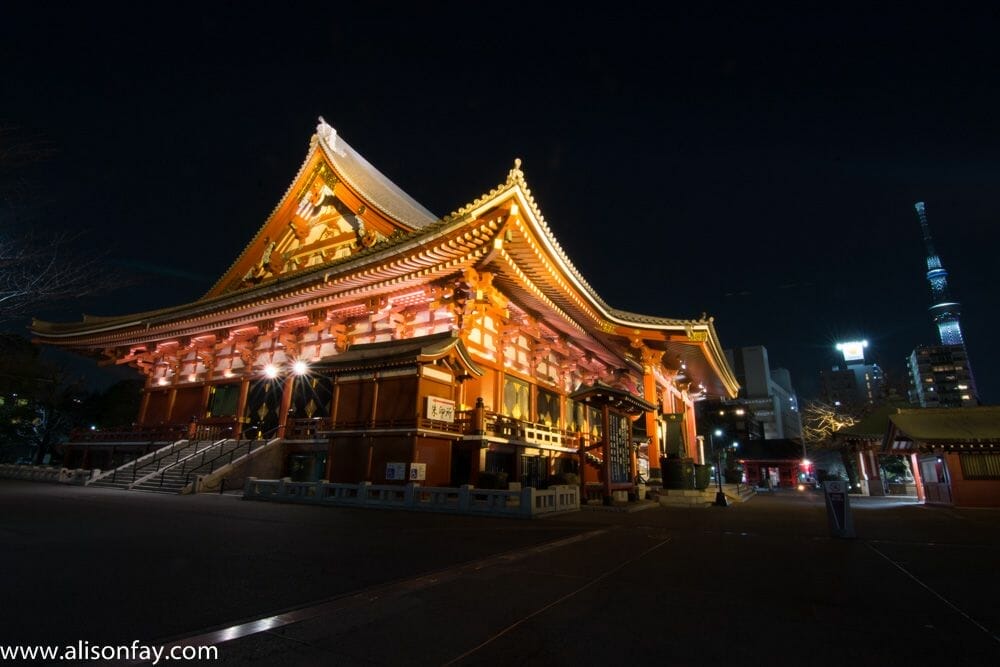
Passing through the Kaminarimon, you’ll reach the iconic Sensoji temple, the oldest and most popular temple in Tokyo. The temple is accompanied by a 200-meter long shopping street called Nakamise, offering a variety of Japanese souvenirs and gifts such as folding fans, yukata, and omiyage. The temple’s main hall is open from 6:00 am until 5:00 pm, and the temple grounds are always accessible, with the temple being illuminated until around 11 pm every night.
Originally built in 645 century, the current temple is a postwar reconstruction. The temple is said to have been built after two brothers fished a statue of Kannon, the goddess of mercy, out of the Sumida river. Despite putting it back, the statue kept returning to them, so Sensoji was built nearby for the goddess of Kannon.
As you approach Sensoji, you’ll walk down a 200-meter long shopping street called Nakamise that will lead you to the second temple gate, Hozomon. These historical shops sell a range of Japanese souvenirs such as folding fans, yukata, and omiyage (food that is gifted to friends, family, and coworkers) and some less traditional souvenirs such as fridge magnets, and keychains.
Beyond the Hozomon gate, is Sensoji’s main hall, pagoda, and slightly off to the left is the Asakusa Shrine.
The Sensoji temple main hall is open from 6:00 am until 5:00 pm (6:30 am from March to October). The temple grounds is always open, and the temple is lit up until around 11 pm every night. The temple is even more magnificent looking at night than it is during the day, making it a good place to visit after sundown. Plus, visiting at night after the crowds have gone, allows you to benefit from a more peaceful visit. Although the main hall is closed at night, you will still get to see some locals coming to pray at the temple.
Shin-Nakamise Shopping Street
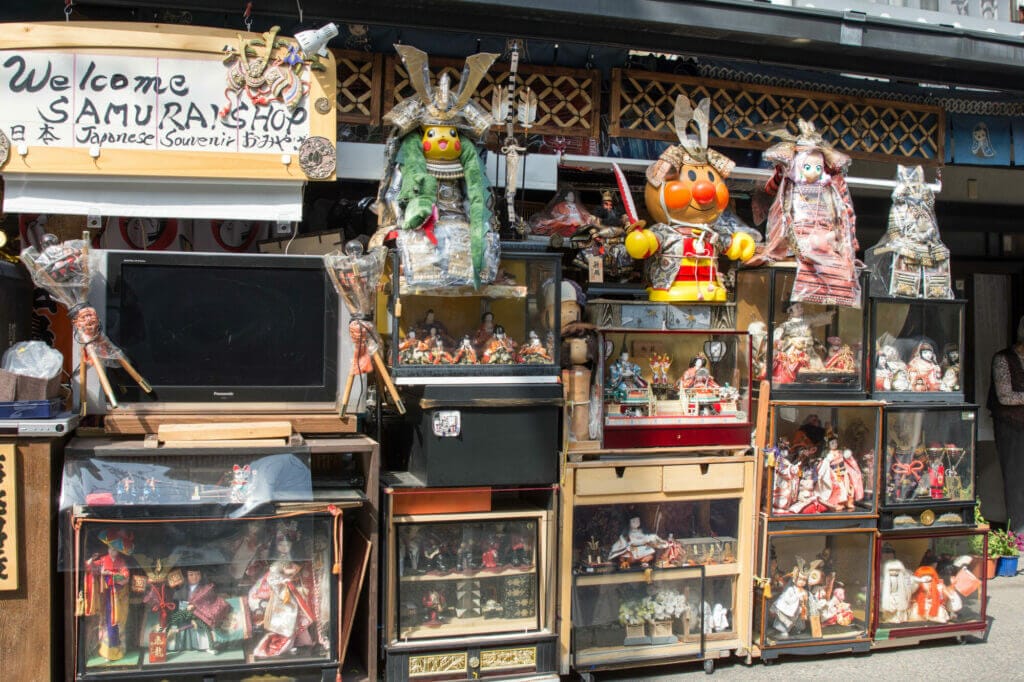
Next to the Sensoji temple, the Shin-Nakamise Shopping Street houses various shops, restaurants, and arcades. This streets well wroth checking out as well.
Sensoji’s Five-Story Pagoda
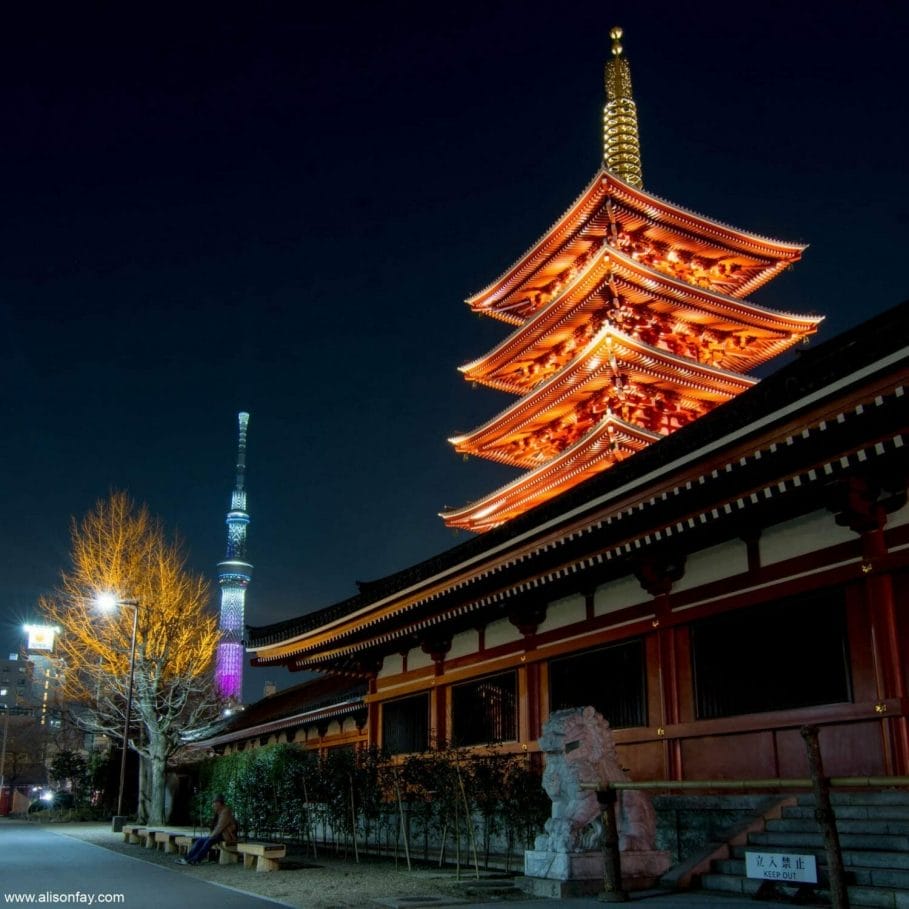
Within the temple grounds, the Sensoji Five-Storied Pagoda stands tall at 53 meters. Originally built in 942, the pagoda was reconstructed in 1648. It is the second tallest pagoda in Japan and houses Buddha’s ashes on its top floor, a gift from the Sri Lanka Government.
Asakusa Shrine
The Asakusa Shrine, (also called Sanja-sama meaning Shrine of the Three Gods) was built during in 1649, and, is one of two buildings in the area that managed to survive World War 2.
The shrine is one of the most famous Shinto shrines in Tokyo and is located to the left of Sensoji’s main building.
Due to its history, the temple is a designated Important Cultural Property meaning that it is of significant importance to Japanese people.
Dempoin Temple
Adjacent to the Sensoji temple, the Dempoin Temple offers a serene view, although it is currently closed off to the public.
Hanayashiki

Hanayashiki is a small theme park, containing 20 rides, is located in the center of Asakusa. The theme park opened in 1883 and is home to Japan’s oldest steel track rollercoaster and a haunted house.
A lot of the rides have been updated but it is still quite a basic theme park due to its small size. This little theme park is worth a visit if you are travelling with children and want an alternative to the typical sightseeing Tokyo normally offers.
Tokyo Sky Tree
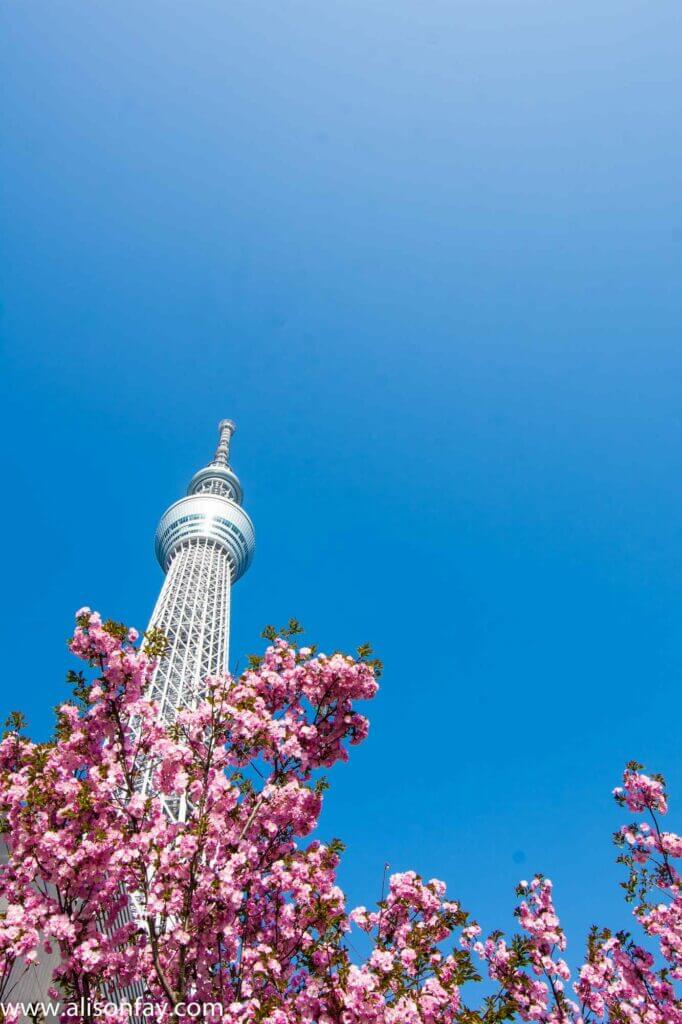
The Tokyo Sky Tree is the second tallest structure globally and offers breathtaking views of Tokyo. It features two observation decks, a shopping and food court area, and various attractions throughout the year.
On a clear day you can see Mount Fuji from the Tokyo Sky Tree. I recommend trying to time your visit for around sunset, allowing time to queue up. The tower can get really busy, and you’ll have to queue for tickets and then again to access to the tower unless you reserve online or buy a fast pass.
I recommend arriving at least 1 hour on weekdays and 2 hours on weekends before sunset to give you ample time to get your tickets, and queue for the elevator.
For disabled visitors, a 50% discount is available for same day tickets but make sure you bring along proof of disability. Please contact the Tokyo Sky Tree to confirm what they accept as proof of disability.
Ushijima Shrine
Ushijima Shrine, built in 860, is a shinto shrine located in the Sumida Park, on the Tokyo Sky Tree side of the Sumida River.
Inside the temple grounds is a statue of a cow, that is said to have healing powers. If you stroke the cow in an area where you are suffering pain, then it is said it will help heal that area.
Sumida Park and Sumida River
For a peaceful retreat, visit Sumida Park on both sides of the Sumida River, offering beautiful views of the Sky Tree and the Asahi Beer Hall. During spring, the park is ideal for hanami (flower viewing) with over 1000 cherry blossom trees.
Rokku Entertainment District
Before the war, Rokku was Tokyo’s leading entertainment district. It was once filled with restaurants, bars, theaters, street performers, brothels, and more. Now, the district mainly boasts a range of shops such as Mega Don Quijote, restaurants such as Yoshinoya and Pachinko + Slot parlors.
Asakusa Culture Tourist Information Center
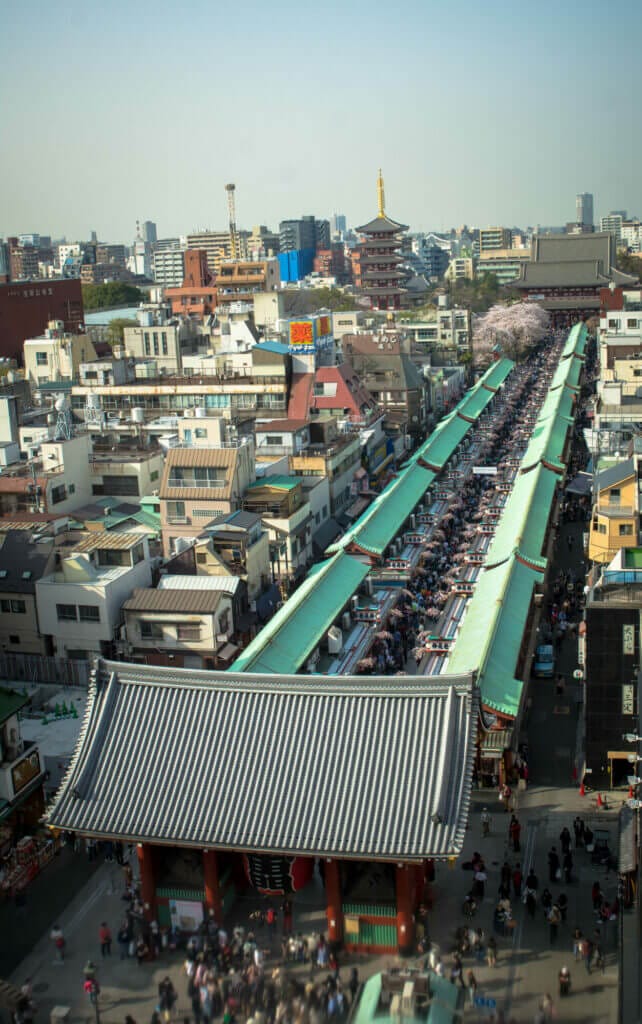
Enjoy a free view over Asakusa, Sensoji, and towards the Sky Tree from the Asakusa Culture Tourist Information Center. There is an elevator which will take you to the free observation area. Sadly, using a tripod is not allowed. After taking in the view, make your way down each floor (either by stairs or elevator), viewing each of the floors different exhibits. Free help and information about Asakusa is available on the ground floor to tourists who may need it.
Drum Museum
The drum museum is one of the nosiest museums in Tokyo. The museum contains a range of drums from around the world including Japanese Taiko drums and steel drums from the Carribean. There are several drums available for visitors to play. The museum is located above the Miyamoto Unosuke Nishi Asakusa store. The store itself sells a range of Japanese drums.
Where to Eat and Drink
Asakusa offers a diverse range of dining options, including Suzukien Matcha, World Beer Museum, Asahi Beer Hall, Onigiri Asakusa Yadoroku, and Yoroiya Ramen.
I personally recommend heading to Suzukien Matcha, as they sell some of the best matcha ice cream I’ve ever had.
Suzukien Matcha

Love Matcha? then make sure you visit Suzukien Matcha. This shop offers 7 different intensity levels of Matcha, level 7 being the richest flavoured matcha ever made. Expect to spend around 700yen for 2 scoops of gelato, which might not seem cheap but is well worth it.
The store can get quite busy, and you may be sent to a waiting area around the block where you will be called when it is your turn. You can choose between 1 or 2 scoops, and in a cup or cone. There are other flavors available including seasonal ones such as Sakura with red beans.
I opted for level 7 matcha with black sesame. My friends went for the sakura with red beans with level 5, and level 5 + level 7. We all thoroughly enjoyed our gelato and would recommend this place. If you order level 7, I would recommend is trying to eat the non-Matcha or weaker Matcha flavour first, as level 7 can overpower the other flavours.
Map showing the location of Suzukien Asakusa
World Beer Museum
This beer hall, which, despite its name, is not actually a museum, offers over 150 varieties of beer from all over the world. The beer hall has a terrace which offers views over Asakusa and of the sky tree on sunny, and clear days. Just be aware that this beer hall gets packed most days, so it is worth arriving early to get a seat.
Asahi Beer Hall

The Asahi Beer Headquarters is made up of two buildings. The one looks similar to a glass of beer, with the top part representing the “foam”. The second and the more famous of the two is the one the golden flame (also known as “the golden turd” due to its uh, turd like shape) sits on top of. Located on the 22nd floor of the beer glass shaped building is the “Sky room”, that offers fresh beer and a great view across Asakusa and the nearby Sumida River.
Onigiri Asakusa Yadoroku
Onigiri, are balls of rice containing different fillings and wrapped in seaweed. Onigiri Asakusa Yadoroku is the oldest onigiri specialist in Tokyo and their onigiri is some of the best available throughout Japan. They use different rice depending on the season, and local edo-mae seaweed which is famous for its rich flavour. They have a range of fillings from all over Japan, plus some seasonal ones. As they stay open until 2 am, this is the perfect place to grab a late night bite to eat.
Budget: 260-1000yen
Opening times:
Lunch – 11:30am until 5:00pm, Monday to Saturday
Dinner – 6:00pm until 2:00am, Monday to Sunday. Closed Wednesdays, and the second and fourth Tuesday of the month. May close sooner if they run out of rice.
Yoroiya Ramen
It’s said that Shoyu Ramen originated from Asakusa, and Yoroiya is the perfect place to taste this traditional dish. Yoroiya has been serving their traditional shoyu ramen for over 20 years. The restaurant is located a few minutes from Sensoji temple and 5 minutes from Asakusa Station exit 1.
Budget: 1000yen
Opening times: 11:00 am until 8:30 pm, 7 days a week.
Accessing Asakusa

Asakusa is accessible via Asakusa Station and is a vibrant district offering a blend of traditional and modern attractions, making it a must-visit destination in Tokyo.
- If coming from Akihabara, take the Tsukuba Express Line towards Tsukuba.
- If coming from Shibuya, Harajuku or Ginza take the Ginza lines towards Asakusa.
- If you are coming from Shinjuku, you will need to first take the Maranouchi Line towards Tokyo, and swap trains at Akasaka-Mitsuke to the Ginza line towards Asakusa.
You can also get to Asakusa using the Tokyo Water Bus which leaves from some popular areas of Tokyo such as Odaiba.
Map of Asakusa
Frequently Asked Questions
Where can I find the best street food in Asakusa?
Asakusa is known for its delicious street food, and there are many places to find it. Some of the best options include Nakamise Shopping Street, which has many food stalls selling traditional Japanese snacks like senbei (rice crackers), taiyaki (fish-shaped cakes filled with sweet red bean paste), and dango (sweet rice dumplings). Another great option is Asakusa Hoppy Street, which has a variety of izakaya (Japanese-style pubs) that serve delicious food and drinks.
Can you suggest a romantic itinerary for a day in Asakusa?
If you’re looking for a romantic day in Asakusa, start by visiting Sensō-ji Temple and exploring Nakamise Shopping Street. After that, take a stroll along the Sumida River and enjoy the views of Tokyo Skytree. For lunch, head to Asakusa Sushi Ken, which serves some of the best sushi in the area. In the afternoon, visit the Asakusa Culture Tourist Information Center for some amazing views of the city. Finally, end your day with a romantic dinner at Asakusa Imahan, which serves delicious sukiyaki (Japanese hot pot).
What unique shopping experiences does Asakusa offer?
Asakusa is known for its traditional shopping streets, and there are many unique shopping experiences to be had. Nakamise Shopping Street is a great place to find traditional Japanese souvenirs like fans, chopsticks, and yukata (summer kimono). Another unique shopping experience is visiting Kappabashi-dori, which is a street filled with shops selling kitchenware and restaurant supplies. Here, you can find everything from Japanese knives to plastic food samples.
What cultural experiences shouldn’t be missed in Asakusa?
Asakusa is full of cultural experiences, but some of the top ones include visiting Sensō-ji Temple, exploring Nakamise Shopping Street, and trying on a yukata (summer kimono) at one of the many rental shops in the area. Another great cultural experience is attending a traditional Japanese tea ceremony at a tea house like Suzukien. Finally, don’t miss the opportunity to watch a traditional Japanese performance like kabuki or bunraku at the nearby Kabukiza Theater.
Wondering what apps you should use during your time in Japan? Then check my guide to the most useful travel apps for Japan. .

Going to Japan next week, and will be there for 2 weeks! great guide.
Great guide, thanks for sharing
OMG I cant wait to try lvl 7 gelato! Looks so good. I love love love mactha
Super helpful! Thanks. Love your photos.
Thanks for sharing. Nice Information
Ouu never heard of this place! Adding it to my Japan bucket list now! 😀
Tokyo is on our list of places we want to travel to, so this is full of really interesting tips. I love how somewhere so technically advanced is also steeped in such wonderful history.
It looks so beautiful. I’ve always wanted to go to Tokyo, now I want to go even more
Oh wow this is so detailed, it is perfect for anybody who is thinking about going.
I would love to go to Tokyo, can’t see it happening anytime soon unfortunately but maybe one day!
What a brilliant guide! On my bucket list, so pinning this one for later.
I’ve never been to Japan but it’s on my must-see places list. I hadn’t even heard of Asakusa but it sounds like there is so much to do there!